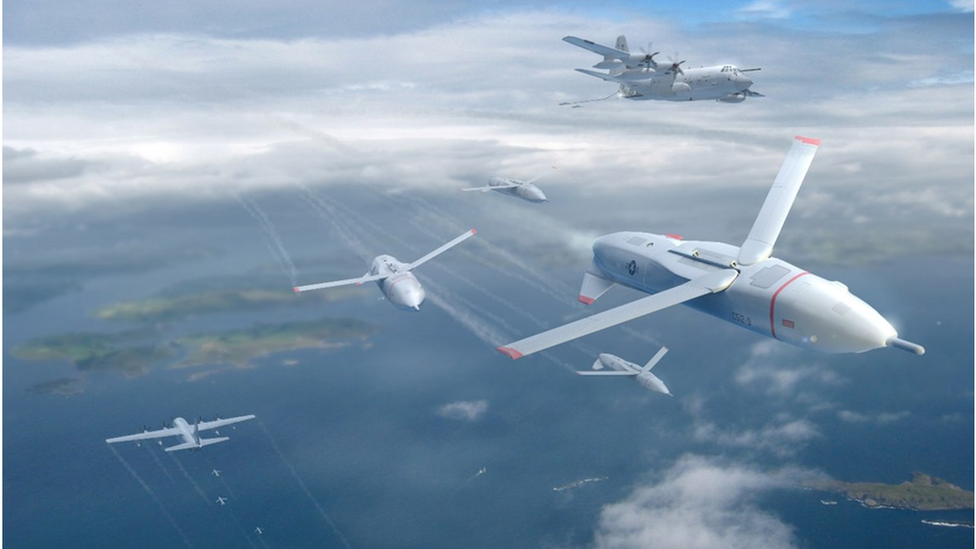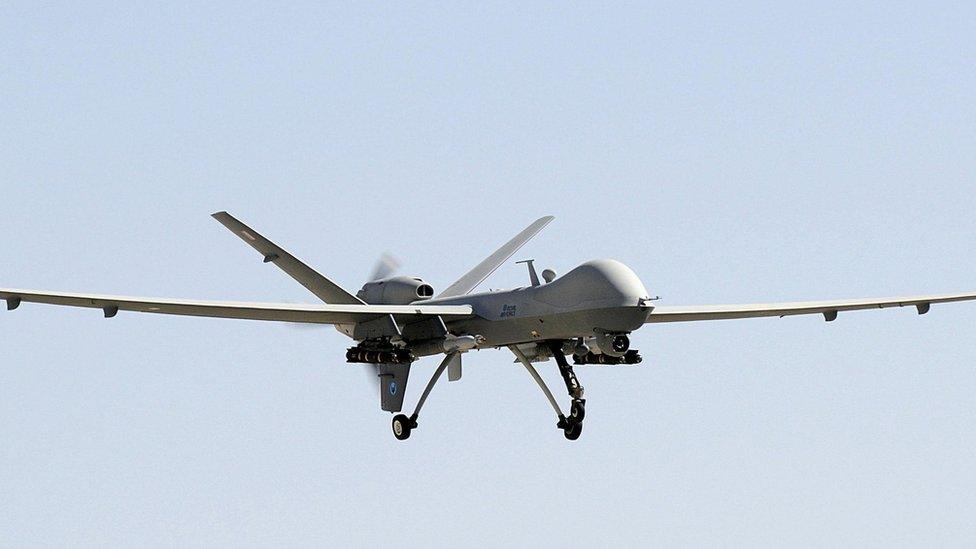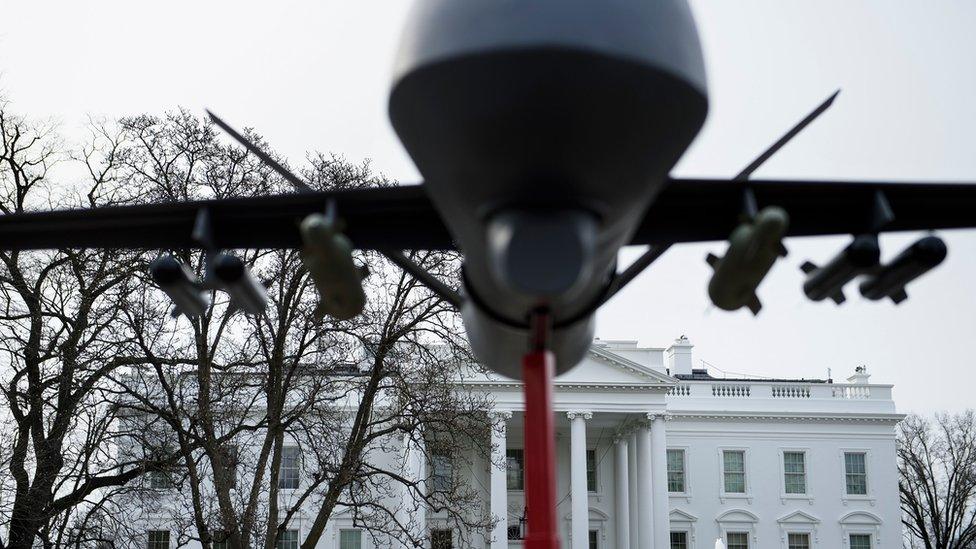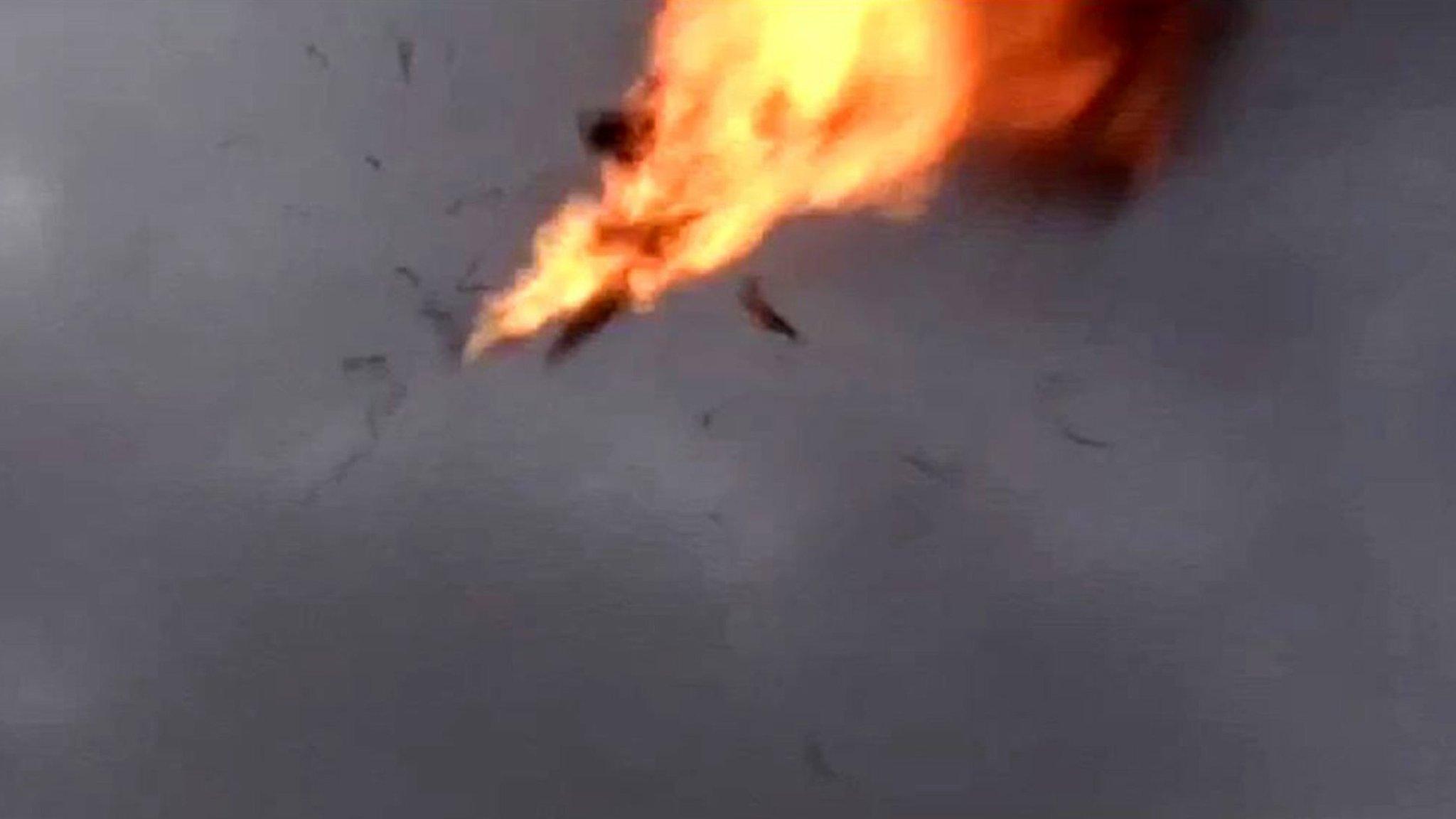How swarming drones will change warfare
- Published

Swarms of drones may work in a similar way to birds or insects
The swarm robots are coming and they could change the way wars are fought.
In February, the defence secretary said "swarm squadrons" will be deployed by the British armed forces in the coming years.
The US has also been testing interconnected, co-operative drones that are capable of working together to overwhelm adversaries.
Low-cost, intelligent and inspired by swarms of insects, these new machines could revolutionise future conflicts.
From swarming enemy sensors with a deluge of targets, to spreading out over large areas for search-and-rescue missions, they could have a range of uses on and off the battlefield.
But just how different is "swarm" technology from the drones that are currently used by militaries across the globe? The key is self-organisation.
"If you imagine a football match, a coach isn't going to tell the players from the sidelines exactly where to run and what to do," says Paul Scharre from the Center for a New American Security think tank.
"Players are going to figure that out on their own. Similarly, the robot agents need to coordinate among each other what actions to take."
Instead of being individually directed by a human controller, the basic idea of a drone swarm is that its machines are able to make decisions among themselves. So far the technology has been at an experimental stage, but it is edging closer to becoming a reality.
Swarms come in different shapes and sizes. The US Defense Advanced Research Projects Agency (DARPA), for example, has been working on a programme dubbed Gremlins, external; micro-drones the size and shape of missiles, designed to be dropped from planes and perform reconnaissance over vast areas.

An artist's concept of DARPA's Gremlin swarm drones
On the other side of the spectrum is the larger XQ-58 Valkyrie drone, measuring almost 9m in length. It has been called a 'loyal wingman, external' for a human pilot - able to carry precision-guided bombs and surveillance equipment. It recently completed its first successful test flight, although the eventual aim is for it to work in a group alongside a manned fighter jet.
In either case, the biggest advantage of a 'swarm' is the ability of machines to work together in numbers. And when it comes to the battlefield, numbers matter.
"Swarming allows you to build large numbers of low-cost expendable agents that can be used to overwhelm an adversary," says Mr Scharre. "This reverses the long trend of rising aircraft costs and reducing quantities.
"And unlike having a large number of soldiers, robotic agents can coordinate on a scale that would be impossible for humans."
Birds and bees
Flinging a barrage at a defence system is one thing, but that could be done with a sack of rocks. The key to the swarm is that it's smart enough to coordinate its own behaviour.
It's not only the military that's interested in this problem. Dr Justin Werfel is a senior research scientist at Harvard's Wyss Institute for Biologically Inspired Engineering.
"In a natural swarm of birds or bees, all individuals are doing their own thing. Each one has its own brain, knows what it can see for itself," he says. "You don't have an explicit hive mind. The queen bee is not giving instructions to everyone.
"The challenge is how you build the individuals so that the collective does what you want."
One robotic construction project run at Harvard, for example, takes inspiration from termite colonies and how they build enormous, elaborate structures without central control. They do this using a mechanism known as "stigmergy", which boils down to one animal leaving signals in an environment for others to react to.
The "termite" robots in action - speeded up 5 x and then 15 x real-time
"The idea is that by leaving information in the environment where it's most relevant, individuals can communicate," says Dr Werfel. "Ants do this by leaving chemical trails, termites do a similar thing about where soil has been put down in a mound."
Flocks of birds are another inspiration for researchers in this area. Watch a murmuration of starlings and it seems to move with a collective intelligence, but the animals are actually each responding to subtle changes in speed and direction. Information ripples across the flock in a split second, and this decentralised behaviour is exactly what drone researchers want to replicate.
But applying these ideas to a battlefield presents issues, namely that a combat zone is a lot more chaotic than a construction site or a quiet patch of sky. For a robotic swarm to work effectively, it has to respond not only to missiles whizzing around but electronic attacks on its communications and GPS.
At the tail end of last year DARPA announced it had done exactly that, using its Collaborative Operations in Denied Environment (CODE) project to equip a squad of drones with the ability to "adapt and respond to unexpected threats, external" high above the Arizona desert, even after human communication was knocked out.
But if a flock of drones is able to "accomplish mission objectives without live human direction", as DARPA says, does that make it an autonomous weapon? There have been calls to ban artificial intelligence systems that are capable of killing without any human intervention. Where do the lines around control lie, when you have a swarm that can make its own tactical decisions?
Search and rescue, search and destroy
There may be some time needed to find the answers to these questions. Mr Scharre says it will be "a while before we see this come to fruition in a really dramatic way."
In the short term, the experiments continue. This month a swarming drone "hackathon, external" will take place, organised by the UK's Defence Science and Technology Laboratory (DSTL) and the US Air Force Research Laboratory (AFRL). It is not aimed at developing attack swarms, however, but new ways to help emergency services deal with wildfires.

Last year's wildfires led to the largest search operation in California's history
"A drone swarm should reduce the operator burden, who could task it to, for example, find lost members of the public or perhaps provide a real-time map of a large advancing fire on several fronts, similar to California in 2018," says Tim Wright, Aerospace Systems Group Leader at the DSTL.
Could these systems also be considered for wider military applications? "We will of course seek to exploit any means of reducing the risk of harm to our emergency services and forces alike," he adds.
Whether or not the results of the hackathon one day wind up on a battlefield, it seems the use of swarm military technology is inevitable. Mr Scharre compares it to the development of precision-guided weapons, tested and refined through the 1970s and 1980s, but only coming into their own during the first Gulf War of the early 1990s.
That war in many ways set the template for conflicts in the following decades. Self-organising swarms of autonomous machines could well do the same for wars to come.
- Published11 February 2019

- Published7 March 2019

- Published10 January 2019
